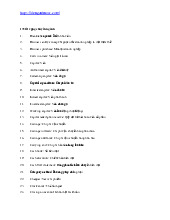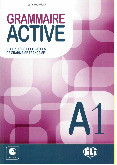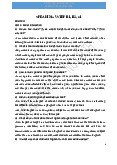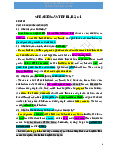



Preview text:
Pay for Delay: AndroGel Avoids Competition1
The United States Federal Trade Commission (FTC) has filed suit against pharmaceutical
company Watson Pharmaceuticals over its agreement with Solvay Pharmaceuticals to not market
a generic version of Solvay’s drug AndroGel for nine years. In turn, Solvay paid millions of
dollars to Watson (and another generic drug maker, Paddock Laboratories). The FTC alleges that
this “pay for delay” payment scheme results in reduced competition and higher drug costs, and
violates laws against the Restraint of Trade. Case Summary
In the 1990s, a partner of Solvay Pharmaceuticals, Inc. developed a drug treatment for low
testosterone levels in males, a condition known as hypogonadism. Their development efforts
resulted in AndroGel, the first testosterone-gel product approved by the Food and Drug
Administration (FDA). The FDA approved the drug in 2000, and awarded Solvay with a period
of statutory exclusivity under the Hatch-Waxman Act. The Hatch-Waxman Act is a federal law
dating back to 1984 outlining the process for generic drug manufacturers to be able to enter and
compete in the market, while also maintaining periods of exclusivity to allow pharmaceutical
companies to recoup investment in costly R&D. Solvay filed for a patent on the drug, which was granted in 2003.
AndroGel’s success in the market drew the attention of generic drug manufacturers Watson
Pharmaceuticals and Paddock Laboratories. In 2003, both Actavis and Paddock filed applications
with the FDA for Abbreviated New Drug Applications (ANDAs). In so doing, they claimed that
the patent issued to Solvay was invalid, and that they should be allowed to market generic
versions of AndroGel. These generic drugs would have the same active pharmaceutical
ingredient, and would be assured of providing no significant difference in quality, safety, and
efficacy as AndroGel. Solvay sued Watson and Paddock for patent infringement.
By 2006, AndroGel was Solvay’s top-selling pharmaceutical product, with U.S. sales of over
$300 million. However, in early 2006, the FDA gave Watson final approval to market a generic
version of AndroGel, which would have significantly reduced the profits Solvay was earning.
The patent infringement lawsuit was still pending, but Watson and Paddock would soon be able
to market their generic products.
Prior to a definitive legal outcome, the parties reached a settlement in which Solvay would make
payments to Watson and Paddock in exchange for their agreement to defer launching a generic
form AndroGel until 2015. These payments were in the form of co-promotion deals, whereby
Watson would agree to promote AndroGel to physicians, and earn a share of the profits. This sort
of payment is referred to as a reverse payment agreement, since the patent-holder agrees to a
settlement in which it pays the company it is suing (rather than the other way around). Solvay
1 Kyle Anderson, Michael Baye, and Jeffrey Prince prepared this case to serve as the basis for classroom discussion
rather than to represent economic or legal fact. The case was written using the public documents involving Case No.
CV 09-598 MRP, Federal Trade Commission and The State of California v. Watson Pharmaceuticals, Par
Pharmaceutical Companies, Paddock Laboratories, and Solvay Pharmaceuticals.
projected that the payments to Watson would be anywhere from $19 million to $30 million per
year over the life of the agreement.
Generic Drugs and the Regulation of the US Pharmaceutical Industry
The pharmaceutical industry is a significant and heavily-regulated industry in the US economy.
The Drug Price Competition and Patent Term Restoration Act of 1984 (known as the “Hatch-
Waxman Act” after its sponsors), established the regulation of generic pharmaceuticals in the
market. Prior to 1984, there were relatively few generic drugs, and the Congress sought to
facilitate competition from lower-priced generic drugs, while maintaining incentives for
pharmaceutical companies to invest in developing new drugs.
A company seeking to launch a new drug must file a New Drug Application with the FDA
demonstrating the safety and efficacy of the product. A company that is seeking to market a
generic version of a drug files an Abbreviated New Drug Application (ANDA). If the company
that made the original drug holds a patent, then as part of the ANDA the generic-maker must
certify that the generic either does not violate the patent, or that the patent is invalid. The patent
holder can then file a patent-infringement lawsuit against the generic manufacturer in order to
prevent the generic drug from coming on the market.
Generic pharmaceuticals entering into the market are typically priced significantly lower than
name-brand pharmaceuticals. Prices then tend to fall even further when more than one generic
producer provides a drug. Due to the lower prices, many health insurance plans and Medicaid
plans have adopted policies to encourage the substitution of generic drugs over branded drugs in
order to reduce healthcare costs. As a result, generic drugs typically capture a significant market
share in a relatively short amount of time.
Consumers save more than $10 billion per year by using generic drugs instead of the branded
drugs. A 2007 study of retail drug stores indicated that the average retail price of a brand-name
prescription drug was $119, while retail price for a generic prescription was $34. AndroGel
Solvay Pharmaceuticals markets AndroGel as a pharmaceutical gel containing synthetic
testosterone. Synthetic testosterone has been available in pharmaceutical form since the 1950s.
Pharmaceutical gel products had also been around for decades. However, AndroGel was the first
application of synthetic testosterone in gel form.
Solvay did not develop the formulation for AndroGel, but licensed it from the Belgian
pharmaceutical company Besins, which had developed its formulation. Besins licensed the
exclusive rights to Solvay, and also manufactured it for Solvay once the drug received FDA
approval. AndroGel was approved by the FDA in 2000 for treatment as a testosterone
replacement therapy for men with low testosterone. Low testosterone is associated with
advancing age, certain cancers, diabetes, and HIV/AIDS, and can result in fatigue, muscle loss, and erectile dysfunction.
AndroGel sold very well in the US market, with annual sales exceeding $400 million by 2007.
AndroGel was Solvay’s best-selling product, accounting for one third of Solvay’s U.S. revenue
by 2007. The prescription prices far exceeded Solvay’s cost of obtaining the product from
Besins, even when factoring direct expenses and marketing and selling costs. The result was that
AndroGel was an extremely profitable product.
In 2000, Solvay filed for patent protection relating to AndroGel. Since testosterone therapy had
been around for decades, the patent was specific to the use of a particular pharmaceutical gel
formulation containing testosterone and other ingredients in certain amounts. The US Patent and
Trademark office issued Patent No. 6,503,894 to Solvay on January 7, 2003, which provided
patent protection for the AndroGel formulation that would last until 2020.
In May 2003, Watson and Paddock filed for approval with the FDA to market a generic version
of AndroGel. As part of their application, they certified that the patent on AndroGel was invalid
according to the guidelines outlined in the Hatch-Waxman Act. Solvay sued Watson and
Paddock for patent infringement, a move which automatically delayed FDA approval of the
generic drugs until January 2006. Threat of Entry
By 2006, the lawsuits on the patent infringement case were still pending. Solvay was concerned
that the generic products would soon be launched. Solvay estimated that AndroGel would lose
90% of its sales within a year of the launch of the generic product. The result would be that
generic competition would cut Solvay’s profits by $125 million per year.
Watson projected a similar outcome, forecasting that the price of the generic drug would be
about 75% lower than AndroGel within a year of entry, and that generics would capture 80% of
the market. Paddock estimated that the generic price would be as low as 15% of AndroGel’s
retail price. Both Watson and Paddock began making investments to prepare to launch the
generic versions of their drugs, including spending $750,000 on commercial manufacturing
equipment to produce the drugs.
In spite of the dramatic impact of the marketing of the generic drugs, Solvay did not pursue a
court injunction against the competitors on the patent infringement case that would have
prevented entry in the market.
Settlement Negotiations
Aware that entry by generic firms would dramatically reduce profits from AndroGel, Solvay
sought a settlement with the two firms. In September 2006, Watson agreed to a “co-promotion
agreement” in which Watson would receive a high share of the profits generated on sales of
AndroGel to urologists, a group of doctors to which Watson would be responsible for marketing.
In return, Watson would agree not to introduce a generic version of AndroGel until August 2015.
The agreement was projected to result in expected payments of $19 million in 2007, and as much
as $30 million per year by the end of the contract. Both companies would then file an agreement
ending their patent infringement litigation.
Similar negotiations occurred between Solvay and Paddock (who had joined in partnership with
Par Pharmaceuticals). Solvay agreed to pay Paddock $12 million per year for promoting various
Solvay drugs and serving as a back-up manufacturer to Besins. A Besins executive noted in an e-
mail that the “backup manufacturer strategy [was] a partial way to compensate [Paddock] for not
entering the market.” In addition, Paddock agreed to perform sales calls on physicians. Litigation
The State of California and Federal Trade Commission filed a lawsuit in 2009 alleging that the
agreements between Solvay and Watson and Paddock constituted illegal restraint of trade. Since
Watson and Paddock were potential competitors prepared to bring generic competitors on the
market, the agreement was harmful to competition. Further, the effect of the settlement was that
prices remained significantly higher than they would have with entry, leading to significant
consumer harm. The defendants responded that the settlement was the result of a legitimate
pending lawsuit a settlement which made all parties better of – f.
Following rulings in U.S. District Court of California and the Eleventh Circuit Court, the case
would eventually make its way to the Supreme Court of the United States.




